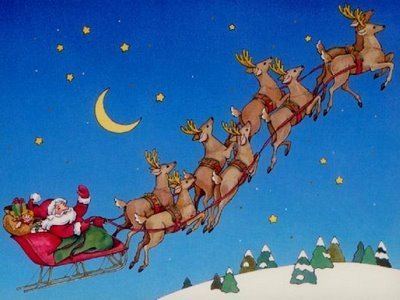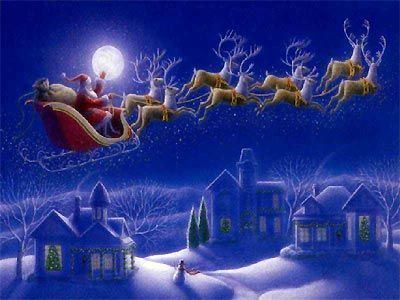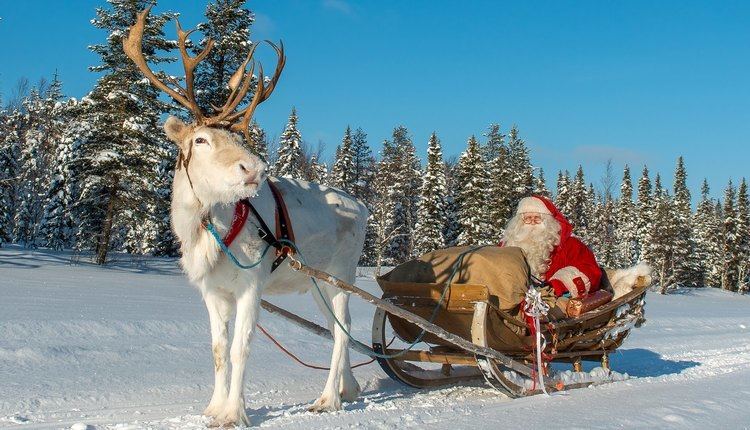Similar L Frank Baum, Clement Clarke Moore, Robert L May | ||
In traditional festive legend, Santa Claus's reindeer pull a sleigh through the night sky to help Santa Claus deliver gifts to children on Christmas Eve. The commonly cited names of the reindeer are Dasher, Dancer, Prancer, Vixen, Comet, Cupid, Donner, and Blitzen. They are based on those used in the 1823 poem "A Visit from St. Nicholas" (commonly called "The Night Before Christmas"), arguably the basis of the reindeers' popularity.
Contents
- List of reindeer
- Single reindeer
- Eight reindeer
- Rudolph the red nosed reindeer
- In comics
- In film
- In literature
- In music
- In television
- References

The enduring popularity of the Christmas song "Rudolph the Red-Nosed Reindeer" has led to Rudolph often joining the list.

List of reindeer

In traditional lore, Santa Claus's sleigh is led by eight reindeer: Dasher, Dancer, Prancer, Vixen, Comet, Cupid, Dunder (variously spelled Donder and Donner), and Blixem (variously spelled Blixen and Blitzen), with Rudolph being a 20th-century inclusion.
The names Dunder and Blixem derive from Dutch words for thunder and lightning, respectively.
Single reindeer
The first reference to Santa's sleigh being pulled by a reindeer appears in Old Santeclaus with Much Delight, an illustrated children's poem published in New York in 1821. The names of the author and the illustrator are not known. The poem, with eight colored lithographic illustrations, was published by William B. Gilley as a small paperback book entitled The Children's Friend: A New-Year's Present, to the Little Ones from Five to Twelve.
Eight reindeer

The 1823 poem by Clement C. Moore "A Visit from St. Nicholas" (also known as "'Twas the Night Before Christmas") is largely credited for the contemporary Christmas lore that includes eight named reindeer.
The relevant segment of the poem reads:
When, what to my wondering eyes should appear,
but a miniature sleigh, and eight tiny rein-deer,
with a little old driver, so lively and quick,
I knew in a moment it must be St. Nick.
More rapid than eagles his coursers they came,
And he whistled, and shouted, and call'd them by name:
"Now, Dasher! Now, Dancer! Now, Prancer, and Vixen!
"On, Comet! On, Cupid! On, Dunder and Blixem!
"To the top of the porch! to the top of the wall!
"Now dash away! dash away! dash away all!"
As dry leaves that before the wild hurricane fly,
When they meet with an obstacle, mount to the sky;
In An American Anthology, 1787–1900, Edmund Clarence Stedman reprints the 1844 Clement C. Moore version of the poem, including the German spelling of "Donder and Blitzen," rather than the original 1823 version using the Dutch spelling, "Dunder and Blixem". Both phrases translate as "Thunder and Lightning" in English, though German for "thunder" is now spelled Donner, and the Dutch words would now be spelled Donder and Bliksem.
Rudolph (the red-nosed reindeer)
Rudolph's story was originally written in verse by Robert L. May for the Montgomery Ward chain of department stores in 1939, and published as a book to be given to children in the store at Christmas time. According to this story, Rudolph's glowing red nose made him a social outcast among the other reindeer. Santa Claus' worldwide flight one year was imperiled by severe fog. Visiting Rudolph's house to deliver his presents, Santa observed Rudolph's glowing red nose in the darkened bedroom and decided to use him as a makeshift lamp to guide his sleigh. Rudolph accepted Santa's request to lead the sleigh for the rest of the night, and he returned home a hero for having helped Santa Claus.
Rudolph's story is a popular Christmas story that has been retold in numerous forms, most notably a popular song, a stop motion television special and an animated feature film. The television special departed significantly from Robert L. May's original story, depicting Rudolph as Donner's son, who lived among Santa Claus' reindeer from birth. In 1998, a film titled Rudolph the Red-Nosed Reindeer: The Movie was released that depicted Rudolph as Blitzen's son.
